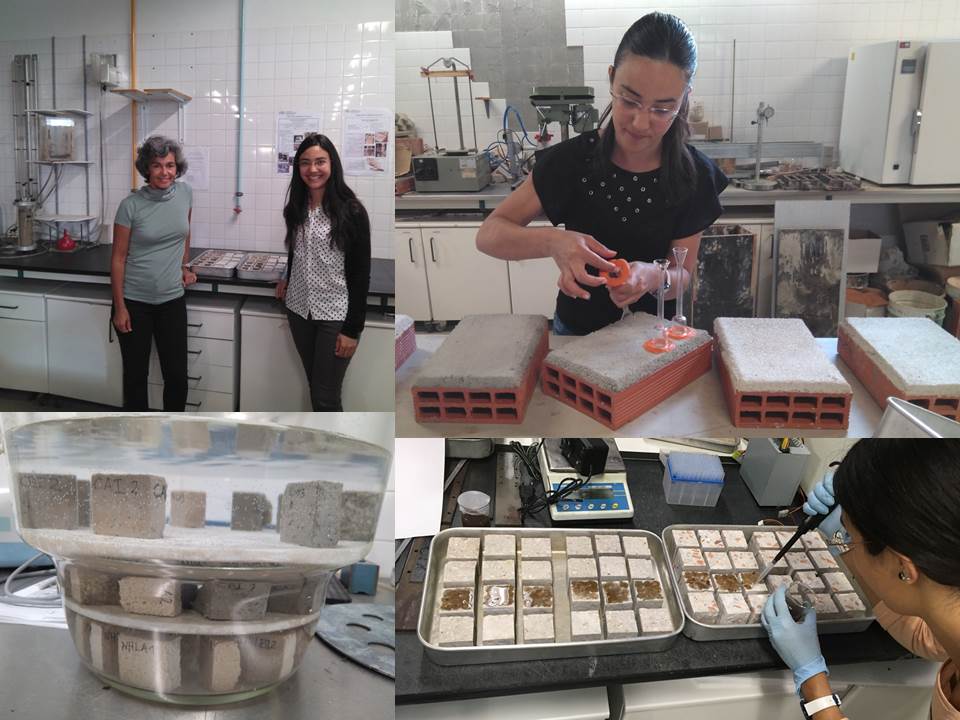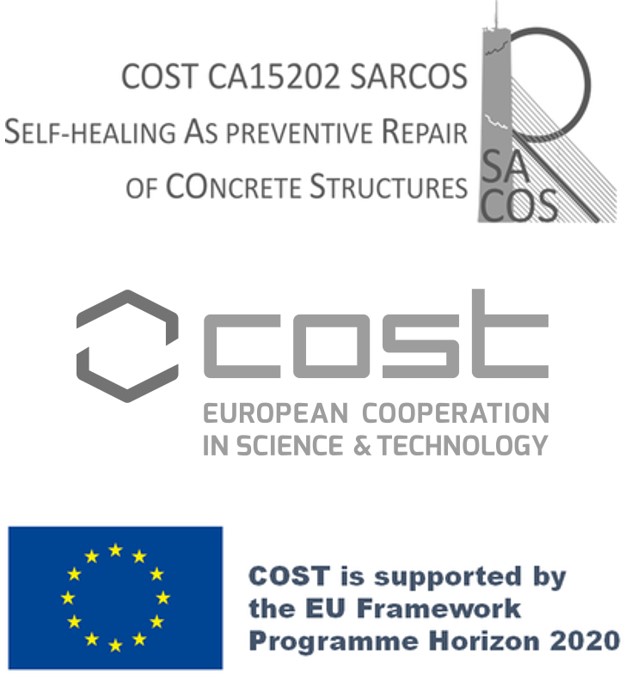Awarded STSMs
| CALL 4.0
Applicant: Julia García González, University of Leon, Leon, (ES)
STSM Topic: Evaluation of the durability improvement produced by different self-healing agents by means of sorptivity tests
Host: UCIBIO-REQUIMTE research group, NOVA University of Lisbon (FCT UNL), Lisbon (PT)
Period: 11/09/2017 to 22/10/2017
Work Plan Summary:
During the STSM, the bioformulated mortars of cement, natural hydraulic lime and air lime were tested to compare their physico-mechanical and durability properties (dynamic elasticity modulus by ultrasonic method, compressive strength, three point flexural strength, density, open porosity, thermal conductivity, ultrasonic velocity, adherence to a masonry brick, dry abrasion resistance, water permeability under low pressure with Karsten tubes, water drop absorption, capillary absorption and drying). For the natural lime mortars the influence of water-lime ratio was also assessed. The results of these tests were analysed and a scientific paper is being written with these findings. The corresponding bibliographic search was developed.
Biotreatment cementicious mortars in comparison with other materials (air lime mortars, calcareous stone, fired brick, adobe, CEB) were tested after 6 months in lab conditions after the application of the biotreatments, with special attention being paid to the permeability behaviour by the water drop absorption test. After these measurements, one re-application of surface biotreatment was developed and the durability was tested again. Other scientific manuscript is being prepared during the STSM to disseminate these findings to the research community. Also samples of conventional and recycled concrete with 50% replacement of natural coarse aggregate by recycled aggregate from construction and demolition waste and earth mortars were tested to assess the healing effect of bio-polymers contained on biomass grown with pine extract. To this end, four surface treatments were evaluated: control (no-product), water (only water was applied over the sample surfaces), bioproduct A (pine extract in a water solution), bioproduct B (the previous but after sonication cycles to crack the cellular membrane and to facilitate the release of polymer chains). These treatments were applied only once on some samples and on three consecutive days on other samples to study the effect of different application methodologies. In addition, this treatments were evaluated under oven controlled and lab temperature to simulate different weather conditions.

Applicant: Dr Snezana Vucetic, University of Novi Sad, Faculty of Technology, Novi Sad (RS)
STSM Topic: Non-destructive evaluation method of the cracks inside the cement-based concrete structures as support to the development of the external bacteria-based repair healing system
Host: Andrijana Sever-Skapin, ZAG (Slovenian national building and civil engineering institute), Ljubljana, Slovenia, Ljubljana (SI)
Period: 19/03/2018 to 28/03/2018
Work Plan Summary:
The leading motivation during the scientific mission (STSM), within the ”SARCOS” COST Action 15202, was to perform and to compare several imaging techniques for the detection and evaluation of the cracks inside the cement-based concrete structures, as well as to observe the influence of newly developed materials on the self-healing capacity of cement materials. The study need to includ the usage of the IR camera in localization of the newly developed materials particle (internal self-healing agents) in cement prisms, as a step forward to further characterization of the presence of developed self-healing materials as external self-healing agents. For this purpose experiments were performed in the environmental conditions (experimental wall, ZAG, Ljubljana, Slovenia), as well as in laboratory conditions. The additional goal of the conducted STSM was the characterization of the newly developed self- healing agents and their influence on the cement materials by Low Vacuum Scanning Electron Microscopy. Finally, this STSM should provide better mutual understanding of the interdisciplinary expertise in complementary fields such as materials engineering, physics and microbiology, merging knowledge of Home institution (Faculty of Technology, Novi Sad, Serbia, group of Prof. J. Ranogajec) and the host laboratory (Slovenian National Building and Civil Engineering Institute, Ljubljana, Slovenia, group of Prof. A. Sever-Skapin).



